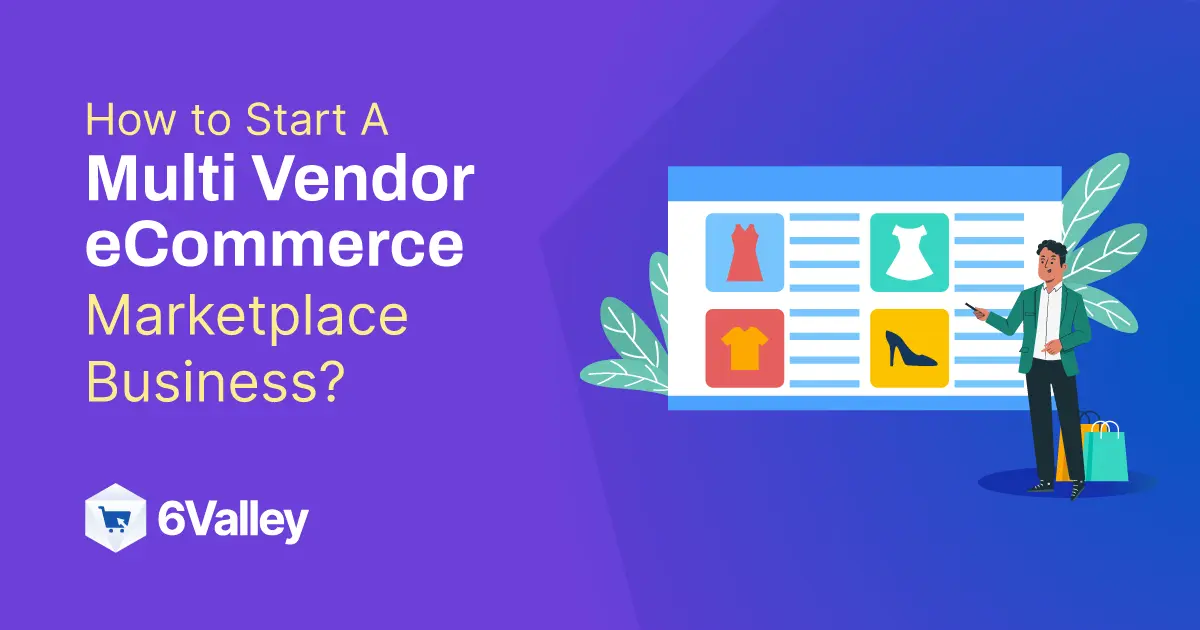Amazon has set and redefined the standards of a multi vendor eCommerce business. From providing high-quality products to excellent customer service, it has proved to be a reliable site for customers. Many entrepreneurs and businesses find it as something ideal and inspirational.
Maybe seeing all this success, you thought – “There’s gotta be a way to do that myself!”
Well, you’re right.
Building a multi-vendor marketplace allows you to connect a network of sellers with eager customers, all on a platform you create. It’s a win-win for everyone.
So, to help you build a successful multi vendor eCommerce marketplace, I have made this comprehensive guide that takes you step by step through the process.
Without any delay, let’s get started!
What is A Multi Vendor eCommerce Business?
In a multi vendor eCommerce business, you create an online marketplace where multiple independent sellers can showcase and sell their products.
Now, let’s break it down a bit further: Imagine a shopping mall. There, you can see a variety of shops with different owners selling their items. The multi vendor eCommerce business is the same, but it is a virtual platform.
With this type of business, you won’t have to think about stocking tons of products yourself. The vendors handle that part. Your job is to create a platform that connects them with eager customers, making your multi vendor marketplace software the go-to spot for online shopping.
Types of Multi Vendor Marketplaces
Before building your own marketplace, you should clearly understand the different types of multi vendor marketplaces.
Let’s dive into the types of multi-vendor marketplaces-
1. All-in-One Platform – This type of marketplace offers a wide variety of products or services across multiple categories, making it a convenient one-stop destination for shoppers looking for diverse options. This type of marketplace is also known as the Horizontal Multi Vendor Marketplace. Example: Amazon, Flipkart.
2. Niche or Product Based – These platforms focus on specific categories or industries that nurture customers with unique interests or preferences. For example, a niche marketplace might be specifically for handmade jewelry or organic skincare products. This type of marketplace is also known as a Vertical marketplace. Example: Etsy, Newegg.
3. Hyperlocal Marketplace – Hyperlocal marketplaces connect buyers and sellers within a specific geographic area. It facilitates transactions for goods and services that are available locally. This could include services like grocery delivery, home maintenance, and flower delivery, all tailored to the local community’s needs. Example: Zepto.
Benefits of a Multi Vendor Marketplace
As an entrepreneur, you always seek ways to maximize profits and minimize risks.
And that’s what you should do!
Now you can think why you should consider the multi-vendor eCommerce business model out of all the existing models.
Here’s why it might be your perfect profit-making match:
Flexibility and control
You’re the Boss!
Businessmen like you have full control over their multi-vendor marketplace’s operations, policies, and regulations. It allows you to adapt to the changing market conditions and implement strategic initiatives.
Diversified income streams
multi vendor marketplaces often generate income through commission fees on each sale. The more vendors you have and the more they sell, the more you potentially earn.
You can also earn through membership fees, advertising opportunities, and premium services. It reduces the reliance on any single source of income.
Scalability
A multi vendor eCommerce platform is built for growth. As you attract more vendors and customers, your business scales effortlessly.
Brand building
Owning a multi vendor marketplace enables you to establish your brand as a trusted platform. With the help of a multi vendor marketplace, you can build your brand identity and foster growth, just like Amazon.
Also Read: How to Build a Multi Vendor eCommerce Marketplace Website with 6Valley
Step-by-Step Guide to Start a Multi Vendor eCommerce Marketplace Business
Here comes the moment we all have been waiting for. Below, I’ll explain the step-by-step process to help you launch your multi vendor eCommerce business.
Step 1: Market research
Before diving into the development process, conducting thorough market research is crucial. You can start by researching the existing multi vendor eCommerce businesses in your zone.
Ask yourself questions like –
- Do you need a marketplace with a wide variety of products or a more focused platform?
- Who are your ideal customers?
Consider your interests, current market landscape, and potential for growth in this step.
Also, having a clear understanding of your target audience is crucial. Create a buyer persona – a detailed profile outlining their demographics, interests, shopping habits, and online behavior. This step will work as an eCommerce business blueprint and guide your platform design and marketing efforts later on.
Step 2: Choose the marketplace type
Selecting your multi vendor eCommerce marketplace type is essential for attracting the right vendors and customers.
Go for –
Horizontal marketplace: If you want to showcase and sell a wide variety of items
Vertical marketplace: To serve within a specific category or industry
Hyperlocal marketplace: To serve within a specific geographic area.
Step 3: Choosing the right marketplace software
Your platform is the foundation of your marketplace. So you need to make a wise and firm decision when going for one.
You can either build a marketplace platform from scratch, use an eCommerce CMS platform, or go for a launch-ready multi vendor marketplace software like 6Valley for the right start to your business.
Here are some key considerations when making this crucial choice:
- Is the platform packed with all essential features?
- Is the platform scalable?
- Is the platform user-friendly and easy to use for all stakeholders of the entire system?
If you want complete control over the system, go for a custom-built multi vendor eCommerce marketplace development solution. But remember, it requires technical expertise, a strong team, and a larger budget.
Does it sound like a hassle? Then, you can go for pre-built solutions like Shopify. However, ensuring optimal performance can be challenging as your business grows, especially when integrating apps and complex themes.
If you want a market-ready solution with all the essential features and panels, go for 6Valley multi vendor eCommerce CMS. With 6Valley, you won’t have to worry about building a team to develop the system from scratch or using simple templates in cloud-based CMS to avoid complexity.
It comes with notable features where –
- You can manage both single-vendor and multi vendor businesses from the same platform.
- Sell digital and physical products from the same platform.
- Reach customers around the globe with international shipping feature.
- Your customers can shop on the go with mobile apps for both Android and iPhone users.
- Choose from a range of themes to match your business style and give your customers a great shopping experience.
After selecting and building your marketplace software, it’s time to transition to the launch phase to get your business up and running.
Step 4: Enlist vendors
Your vendors are your partners in success. After launching the platform, it’s time to onboard the quality vendors out there. After all, you don’t want to compromise with the product qualities showcasing on your website.
Here are some strategies you can take to choose the best ones –
- A clear vendor agreement outlining your expectations. The agreement criteria include product quality, shipping policies, customer service standards, and return policies.
- Offer a fair commission structure. It will bring in more vendors to sell on your platform.
- Highlight how your marketplace will promote their products for business transparency and trust.
Step 5: Implement marketing strategies
Now that your online marketplace is built and your vendors are on board, it’s time to spread the word and attract customers!
You can use social media platforms like Facebook, Instagram, and Twitter to showcase and highlight the unique offerings of your multi vendor marketplace.
You can also create engaging blog posts, articles, or even video tutorials related to your niche. This will attract potential customers searching for information and establish your marketplace as a valuable resource.
Reach out to journalists and bloggers to see if they’d be interested in featuring your marketplace in their articles or reviews. Positive press coverage can significantly boost your credibility and attract new customers.
Implementing influencer marketing, PPC advertising, and email marketing campaigns can significantly raise brand awareness and attract the ideal audience to the platform.
Finally, you can run promotional campaigns to attract new customers to your multi vendor website.
Step 6: Monitor and optimize performance
Once your multi vendor eCommerce marketplace is up and running, it’s essential to monitor its performance and make continuous improvements.
Track key metrics like website traffic, conversion rates ( the percentage of visitors who purchase), and sales figures.
Along with this, seek feedback from both customers and vendors. This information will help you identify areas for improvement and enhance the experience for all.
But this isn’t the end. As the eCommerce business is always evolving, it must be adaptive. Be open to changing your marketing strategies, product offerings, and platform features when necessary.
Final Words
Alright, that’s a wrap! Starting a multi vendor eCommerce business can be rewarding with the right approach and tools.
Remember, building a successful online business takes time, dedication, and a willingness to learn and adapt. But with the right strategies in place, you can create a thriving platform that empowers independent sellers and delights your customers.
See you in the next blog!
FAQs
How can I track the success of my multi vendor eCommerce marketplace?
You can analyze data or key metrics like website traffic, conversion rates (sales), and customer reviews. Use this data to identify success rates, improvement scopes, and optimize your marketplace for long-term success.
Is a multi vendor marketplace profitable?
With a well-defined strategy and effective management, it can be very profitable. multi vendor marketplaces generate profits through commission fees on sales from vendors, subscription fees for premium features, or a combination of both.
What are the benefits of a multi vendor marketplace?
There are numerous benefits of a multi vendor marketplace including:
– Reduced overhead
– A wider range of products
– Scalability
– Increased revenue potential
– Community building
– Data-driven decision making
– Lower Risk
– Brand Exposure
Meet Mehrin! A technical writer with a Computer Science background. She combines her academic knowledge & creativity to transform complex facts into engaging content. With a sharp eye for detail, she keeps readers updated on tech trends. Outside of writing, she’s a visual storyteller, capturing life’s moments through photography.













